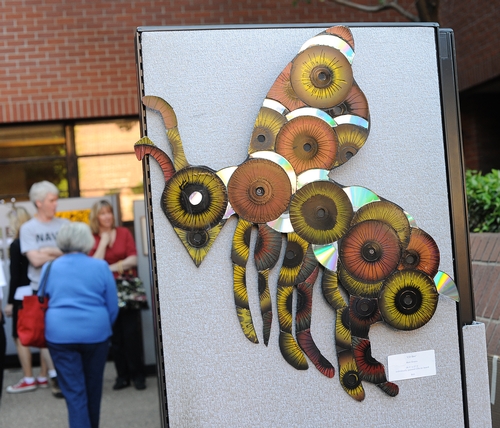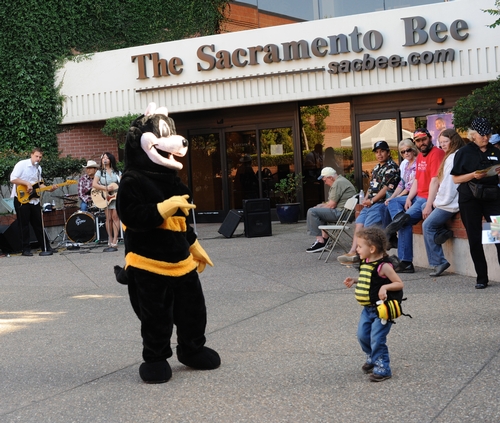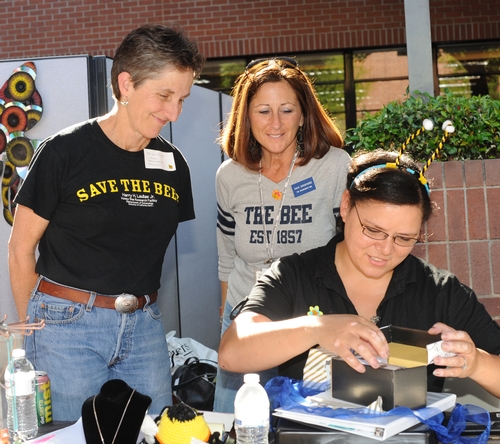- Author: Kathy Keatley Garvey
Insects outnumber us on this earth.
And they always will. By the millions.
Penny Gullan and and Peter Cranston, emeritus professors of entomology at the University of California, Davis, wrote in their textbook, The Insects (Wiley Blackwell) that "Although there are millions of kinds of insects, we do not know exactly (or even approximately) how many. This ignorance of how many organisms we share our planet with is remarkable considering that astronomers have listed, mapped and uniquely identified a comparable diversity of galactic objects. Some estimates...imply that the species richness of insects is so great that, to a near approximation, all organisms can be considered insects."
So it's good to see that when the website,Twisted Sifter, recently chose "The 50 Most Perfectly Timed Photos Ever," three of them were insects.
One insect photo, which they numbered No. 18 (photo by Tustel Ico) depicted a praying mantis on a bicycle. Another, No. 22, showed an unusual bee sting (taken by yours truly) and the third, No. 46, was of a ladybug by Lentilcia on deviantART.
The bee sting photo, which has gone around the world and back, is of Extension apiculturist Eric Mussen of the UC Davis Department of Entomology getting stung in the apiary of the Harry H. Laidlaw Jr. Honey Research Facility. You can see a trail of the bee's abdominal tissue as the bee tries to pull away.
At the time, we were walking through the apiary when he said "Kathy, get your camera ready. The bee's going to sting me." (See Bug Squad entry.) The bee was defending its hive, which is what bees do.
Mussen, with the Department of Entomology since 1976, plans to retire in June of 2014, but like the Energizer bunny, this photo of the bee sting will probably keep on going.
It went from winning a feature photo contest sponsored by the Association for Communication Excellence (ACE), an international association of communicators, educators and information technologists, to being named the Huffington Post's "Most Amazing Photos of 2012"; one of the Sacramento Bee's top 10 news stories of 2012; and My Science Academy's top photos of the year. Along the way, scores of websites named it "Picture of the Day." It also will appear in a number of books.
It's definitely the bee sting felt around the world.

- Author: Kathy Keatley Garvey
Honey bee research at the University of California, Davis, recently received a $900 boost, thanks to artists with a honey of heart—a honey of a heart for the plight of honey bees.
Artists showing their work at the “Bees at The Bee” art show in Sacramento donated a total of $900 from gross sales of $1560 to honey bee research at the Harry H. Laidlaw Jr. Honey Bee Research Facility, UC Davis.
“The art work was peered at, pored over, perused, examined, appreciated, loved and admired by hundreds of eyes on Saturday,” said Sacramento artist and art show coordinator Laurelin Gilmore who thought of the bee-themed show as a way to help honey bee research and boost awareness of the declining bee population ravaged by colony collapse disorder (CCD).
“We were applauded and congratulated on every aspect of this little event, and I for one am bursting with pride for having been any part of it.”
The event, sponsored by the Sacramento Bee, drew hundreds of visitors to The Bee’s open courtyard.
“This was a marvelous event, altogether educational and entertaining, greatly benefiting honey bees and our bee research program at UC Davis,” said Lynn Kimsey, director of the Bohart Museum of Entomology and professor of entomology at UC Davis.
“Laurelin did a terrific job planning the event, with the support the Sacramento Bee, to support the bees.”
Gilmore invited artists from within a 12-county area to submit their work. Some 60 artists submitted a variety of work, including acrylic paintings, watercolors, pen and ink drawings, metal and paper sculptures, photographs, fused glass plates, pendants, a fleece blanket, crocheted multimedia, collages, monoprint-woodcut, neckpiece, individually painted CDs, and a scrimshaw engraving on a mammoth ivory.
A portion of the proceeds from the sale went to UC Davis honey bee research. Artists grossed $1560, of which $900 “is going directly to the UC Davis bee research,” Gilmore said.
Gilmore praised the artists for their “willingness and eagerness to participate in making my little idea grow so tall.”
“The plight of the honey bees is filtered through each artist in a different way, and the results run the gamut from funny to beautiful to profound,” she said.
The “Bees at The Bee” also included live music, refreshments, and educational information about bees. Scoopy, The Bee’s mascot, handed out chocolate bees.
Extension apiculturist Eric Mussen, member of the UC Davis Department of Entomology faculty, displayed a bee observation hive and answered questions about bees, including CCD, the mysterious malady in which adult bees abandon the hive, leaving behind the queen bee, brood and food stores.
Mussen also handed out free samples of Honey Lovers, a new line of candy (fruit chews) by Gimbal’s Fine Candies, San Francisco. Gimbal’s is donating 5 percent of the proceeds from the sale of its Honey Lovers for UC Davis research. Other handouts were from Burt’s Bees, Häagen-Dazs and the Partners for Sustainable Pollination.
Overall, this was a down-to-earth grassroots effort to help the bees, and it blossomed into not only an outstanding art show, but a generous donation to UC Davis for honey bee research.
A tip of the bee veil to Laurelin Gilmore, Pam Dinsmore and the Sacramento Bee for making it all possible.





